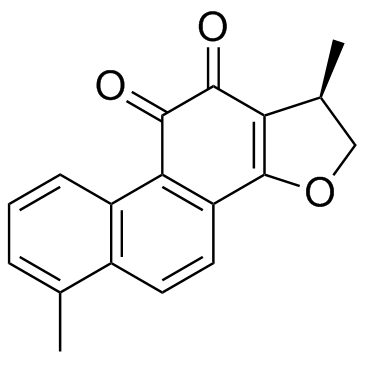Dihydrotanshinone I

Dihydrotanshinone I structure
|
Common Name | Dihydrotanshinone I | ||
|---|---|---|---|---|
| CAS Number | 87205-99-0 | Molecular Weight | 278.302 | |
| Density | 1.3±0.1 g/cm3 | Boiling Point | 479.2±45.0 °C at 760 mmHg | |
| Molecular Formula | C18H14O3 | Melting Point | 214.0 to 218.0 °C | |
| MSDS | Chinese USA | Flash Point | 214.9±28.8 °C | |
| Symbol |


GHS07, GHS09 |
Signal Word | Warning | |
Use of Dihydrotanshinone IDihydrotanshinone I is a natural compound extracted from Salvia miltiorrhiza Bunge which has been widely used for treating cardiovascular diseases. |
| Name | (1R)-1,6-dimethyl-1,2-dihydronaphtho[1,2-g][1]benzofuran-10,11-dione |
|---|---|
| Synonym | More Synonyms |
| Description | Dihydrotanshinone I is a natural compound extracted from Salvia miltiorrhiza Bunge which has been widely used for treating cardiovascular diseases. |
|---|---|
| Related Catalog | |
| In Vitro | In lipopolysaccharide (LPS)-stimulated human umbilical vein endothelial cells (HUVECs), DHT (10 nM) decreases lectin-like ox-LDL receptor-1 (LOX-1) and NADPH oxidase 4 (NOX4) expression, reactive oxygen species (ROS) production, NF-κB nuclear translocation, ox-LDL endocytosis and monocytes adhesion[1]. Dihydrotanshinone I induces caspase dependent apoptosis induced in HCT116 cells. Dihydrotanshinone I induces concentration and ROS dependent caspase activation. Apoptosis induced by Dihydrotanshinone I is completely prevented by Z-VAD-fmk. Apoptosis induced by Dihydrotanshinone I is significantly inhibited by pretreatment of Z-LEHD-fmk but only is partially inhibited by Z-IETD-fmk. Apoptosis induced by Dihydrotanshinone I is significantly increased by caspase-2 knockdown[3]. |
| In Vivo | DHT (10 and 25 mg/kg) significantly attenuates atherosclerotic plaque formation, alteres serum lipid profile, decreases oxidative stress and shrinks necrotic core areas in ApoE-/- mice. DHT dramatically inhibits the enhanced expression of LOX-1, NOX4, and NF-κB in aorta[1]. Dihydrotanshinone I (1, 2, 4 mg/kg) treatment can improve cardiac function, reduce infarct size, ameliorate the variations in myocardial zymogram and histopathological disorders, decrease 20-HETE generation, and regulate apoptosis-related protein in myocardial ischemia-reperfusion rats[2]. |
| Kinase Assay | Cells are treated with various concentrations of Dihydrotanshinone I (3.13-20 µM) for 48 h. For the activity assay, Ac-DEVD-AMC (1 µg/µL), Ac-IETD-AMC (1 µg/µL) or Ac-LEDH-AMC (1 µg/µL) and cell lysate are added into Protease Assay Buffer in 96-well plate. Reaction mixtures with lysis buffer are used as negative controls. Cells treated with DMSO (0.1%) are treated as vehicle control. The reaction mixtures are incubated for 1 h at 37°C. The AMC liberated from the substrates is measured using spectrofluorometer of Victor 2 plate reader with an excitation wavelength of 380 nm and an emission wavelength of 430 nm. |
| Animal Admin | Male ApoE-/- mice (6-8 weeks old) on C57BL/6J background and age-matched wild-type C57BL/6J controls housed in SPF-grade animal facilities with a 12 h light/dark cycle, at 23°C (±2°C). Starting from 6 weeks, the mice are fed with a HCD (54.35% raw grain, 20% lard, 0.15% cholesterol, 15% sucrose, 0.5% Sodium Cholate, 10% yolk powder) for 12 weeks. All ApoE-/- mice are dosed daily via intragastric gavage with 10 and 25 mg/kg Dihydrotanshinone I dissolved in 0.5% CMC-Na or administered 0.5% CMC-Na alone (vehicle control) (n=8 per group). |
| References |
| Density | 1.3±0.1 g/cm3 |
|---|---|
| Boiling Point | 479.2±45.0 °C at 760 mmHg |
| Melting Point | 214.0 to 218.0 °C |
| Molecular Formula | C18H14O3 |
| Molecular Weight | 278.302 |
| Flash Point | 214.9±28.8 °C |
| Exact Mass | 278.094299 |
| PSA | 43.37000 |
| LogP | 3.90 |
| Appearance of Characters | red |
| Vapour Pressure | 0.0±1.2 mmHg at 25°C |
| Index of Refraction | 1.671 |
| InChIKey | HARGZZNYNSYSGJ-JTQLQIEISA-N |
| SMILES | Cc1cccc2c3c(ccc12)C1=C(C(=O)C3=O)C(C)CO1 |
| Storage condition | 2-8°C |
| Water Solubility | ethanol: soluble1mg/mL, clear, orange to red |
|
Dihydrotanshinone-I interferes with the RNA-binding activity of HuR affecting its post-transcriptional function.
Sci. Rep. 5 , 16478, (2015) Post-transcriptional regulation is an essential determinant of gene expression programs in physiological and pathological conditions. HuR is a RNA-binding protein that orchestrates the stabilization a... |
|
|
Comparison of neuroprotective effects of five major lipophilic diterpenoids from Danshen extract against experimentally induced transient cerebral ischemic damage.
Fitoterapia 83 , 1666-1674, (2012) We observed neuroprotective effects of five major lipophilic diterpenes derived from Danshen (Radix Salvia miltiorrhiza) extract, such as cryptotanshinone (CTs), dihydrotanshinone I (DTsI), tanshinone... |
|
|
Modeling gradient elution in countercurrent chromatography: efficient separation of tanshinones from Salvia miltiorrhiza Bunge.
J. Sep. Sci. 35 , 964-976, (2012) Countercurrent chromatography (CCC) is a support-free liquid-liquid chromatography using centrifugal fields to hold the liquid stationary phase. CCC has been widely applied in the separation of variou... |
| 1,6-Dimethyl-1,2-dihydrophenanthro[1,2-b]furan-10,11-dione |
| 1,2-dihydrotanshinone |
| Tanshinone I,dihydro |
| dihydrotanshinone 1 |
| 1,2-dihydrotanshinone I |
| 15,16-dihydrotanshinone I |
| Phenanthro[1,2-b]furan-10,11-dione, 1,2-dihydro-1,6-dimethyl- |
| Dihydrotanshinone I |

